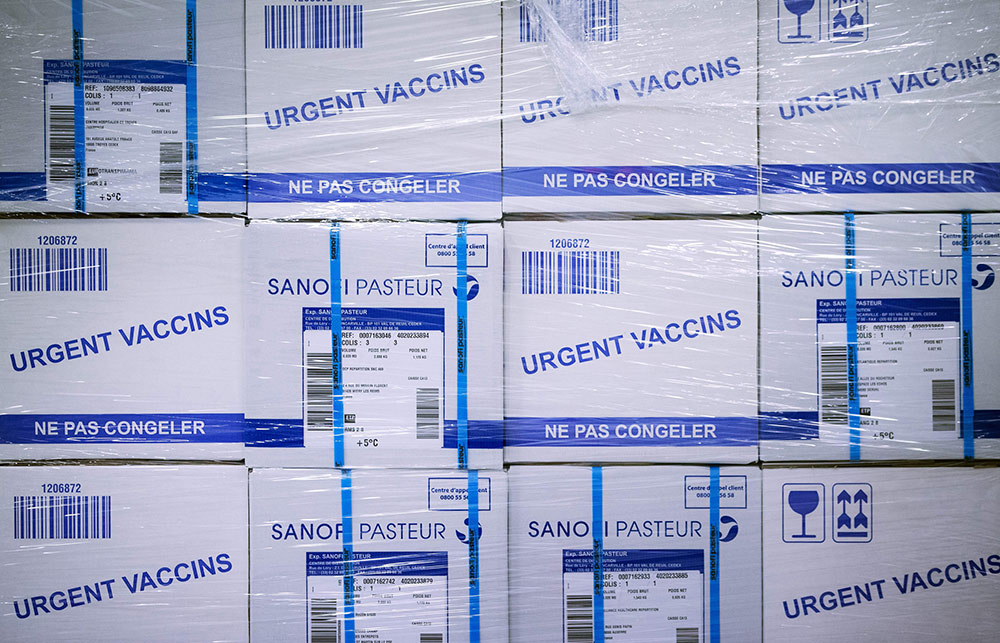
在新冠肺炎疫苗研发的全球竞赛中,从在未经测试的技术上花费数十亿美元,到将临床试验时间从几年压缩到数月——各国已经竭尽了千千万万疫情前想都不敢想的办法。
世界需要这些不计后果的尝试,即使是能够提前一天找到疫苗,这些努力也有价值。但是,在疫苗运输方面,如果我们不能拥有像疫苗研发那样的紧迫性、创造性和投资力度,这一切也都将是徒劳。
疫苗似乎是全球都必需的物品,为什么疫苗的运输过程值得如此不计成本的小心?原因在于,疫苗很脆弱——要求我们的运输能力达到近乎完美的程度。
与大多数疫苗一样,新冠肺炎疫苗需要低温保存。从离开生产厂家到接种,疫苗的环境温度需要在一个精确的范围内固定。
即便在拥有强大供应链的发达国家,这种高标准的运输也很难做到。在基础设施不发达的国家,疫苗的运输过程更是充满风险。在疫苗跨越万里、转手数次运往达喀尔、塞内加尔、印度比哈尔邦或是刚果的医院、诊所时,一旦冷链出现任何差池,疫苗将失去效力,一切努力都将付之东流。
能否接种疫苗不应当被出生地所决定。但如果我们停滞于当下的运输模式,即使过了获得接种权这关,疫苗到达接种者时的有效性将会打上一个问号。
冷链断裂并不是一个新问题,但一直以来饱受忽视。在过去的20年里,发达国家的政府和制药公司进行合作,以更低的价格为发展中国家提供疫苗。但当这些珍贵的疫苗到达入境口岸时,人们对疫苗接下来命运的关注往往就会消退。对于这一现象,有一个挺犬儒的艺术术语:船和祈祷(ship and pray)。
诸如Parsyl的公司正在展开行动。在过去的两年里,该公司与全球疫苗免疫联盟(Gavi)合作,运送带有传感器的疫苗——这些传感器可以在不可逆转的损害产生之前检测到冷链断裂。
正是这些传感器,带给了我们很多启发。
你可能会认为,疫苗在冷链中面临的最大威胁是高温——事实上,情况正好相反。数据显示,冰封的疫苗载体和冰箱故障造成低温环境,其风险要大得多。在一国之内,有近四分之一的疫苗由于温度过低而变质。
但是,深入研究这些数据也会发现一些好消息:大部分的冻害仅仅来自于5%的冰箱。因此,修理这5%的冰箱就能够将疫苗的损失减少一半,以最低的成本和损耗挽救更多的生命。
通过在发货的疫苗中加入传感器,像Parsyl这样的公司将会受益。但是,我们也可以进行有针对性的干预——比如迅速识别和替换损坏疫苗的故障冰箱——这一切都只有通过更精确的数据才可以实现。目前,全球疫苗和免疫联盟发起了一项倡议,在世界各地替换冷链设备。由此,更好的数据将更能针对各种迫切的需要加以改进。
运输级别的数据还将允许采用创新的方法来管理和转移风险。在“船和祈祷”模式下,由于船只保险商的“盲目运行”,为发展中国家的疫苗储备提供保险的成本高得令人望而却步。但是,有了能够监测并将温度信息发送到云端的传感器,地面上的医务人员将有足够的技术能力来防止疫苗损耗,保险商也可以精确地模拟风险。这就是我们上周与伦敦劳合社(Lloyd’s of London)共同宣布的全球健康风险基金(Global Health Risk Facility)背后的理念,该基金将向发展中国家提供新冠肺炎疫苗保险。
但在我们发掘出的数据中,最大的惊喜也许是疫苗运输的速度将提升。如果我们能够缩短冷链运送时间,特别是所谓的“最后一英里”,我们就可以减少将近40%的疫苗损耗。
让当地的物流公司来运送货物,是加快运输的一种实之有效但未得到充分利用的方法。在乌干达的三个地区为300多万人提供服务的疫苗分发工作被移交给东非物流公司“及时货运”(Freight in Time)(该公司使用Parsyl公司的传感器)后,疫苗短缺现象结束了,新疫苗装运所需的交货时间从一个月缩短到了5天。由此,通过“及时货运”,每月的疫苗分发增加了10万剂,同时浪费数量得到了减少。
更好的数据、有针对性的干预措施、更准确的风险管理、对当地合作伙伴的更大信任——这些举措像是一条分界线:跨过它,数十亿人将能够接种到强效疫苗;停滞不前,即使疫苗量产已久,新冠疫情危机也将久久不能散去。
如果我们不能像关注治疗一样关注疫苗运输,我们将永远无法摆脱新冠疫情。(财富中文网)
本•哈伯德是保险技术公司Parsyl的联合创始人及首席执行官,也是劳合社实验室的校友。
编译:杨二一
2020年7月10日,位于法国瓦尔德鲁伊尔的赛诺菲全球配送中心里的冷藏中疫苗。
在新冠肺炎疫苗研发的全球竞赛中,从在未经测试的技术上花费数十亿美元,到将临床试验时间从几年压缩到数月——各国已经竭尽了千千万万疫情前想都不敢想的办法。
世界需要这些不计后果的尝试,即使是能够提前一天找到疫苗,这些努力也有价值。但是,在疫苗运输方面,如果我们不能拥有像疫苗研发那样的紧迫性、创造性和投资力度,这一切也都将是徒劳。
疫苗似乎是全球都必需的物品,为什么疫苗的运输过程值得如此不计成本的小心?原因在于,疫苗很脆弱——要求我们的运输能力达到近乎完美的程度。
与大多数疫苗一样,新冠肺炎疫苗需要低温保存。从离开生产厂家到接种,疫苗的环境温度需要在一个精确的范围内固定。
即便在拥有强大供应链的发达国家,这种高标准的运输也很难做到。在基础设施不发达的国家,疫苗的运输过程更是充满风险。在疫苗跨越万里、转手数次运往达喀尔、塞内加尔、印度比哈尔邦或是刚果的医院、诊所时,一旦冷链出现任何差池,疫苗将失去效力,一切努力都将付之东流。
能否接种疫苗不应当被出生地所决定。但如果我们停滞于当下的运输模式,即使过了获得接种权这关,疫苗到达接种者时的有效性将会打上一个问号。
冷链断裂并不是一个新问题,但一直以来饱受忽视。在过去的20年里,发达国家的政府和制药公司进行合作,以更低的价格为发展中国家提供疫苗。但当这些珍贵的疫苗到达入境口岸时,人们对疫苗接下来命运的关注往往就会消退。对于这一现象,有一个挺犬儒的艺术术语:船和祈祷(ship and pray)。
诸如Parsyl的公司正在展开行动。在过去的两年里,该公司与全球疫苗免疫联盟(Gavi)合作,运送带有传感器的疫苗——这些传感器可以在不可逆转的损害产生之前检测到冷链断裂。
正是这些传感器,带给了我们很多启发。
你可能会认为,疫苗在冷链中面临的最大威胁是高温——事实上,情况正好相反。数据显示,冰封的疫苗载体和冰箱故障造成低温环境,其风险要大得多。在一国之内,有近四分之一的疫苗由于温度过低而变质。
但是,深入研究这些数据也会发现一些好消息:大部分的冻害仅仅来自于5%的冰箱。因此,修理这5%的冰箱就能够将疫苗的损失减少一半,以最低的成本和损耗挽救更多的生命。
通过在发货的疫苗中加入传感器,像Parsyl这样的公司将会受益。但是,我们也可以进行有针对性的干预——比如迅速识别和替换损坏疫苗的故障冰箱——这一切都只有通过更精确的数据才可以实现。目前,全球疫苗和免疫联盟发起了一项倡议,在世界各地替换冷链设备。由此,更好的数据将更能针对各种迫切的需要加以改进。
运输级别的数据还将允许采用创新的方法来管理和转移风险。在“船和祈祷”模式下,由于船只保险商的“盲目运行”,为发展中国家的疫苗储备提供保险的成本高得令人望而却步。但是,有了能够监测并将温度信息发送到云端的传感器,地面上的医务人员将有足够的技术能力来防止疫苗损耗,保险商也可以精确地模拟风险。这就是我们上周与伦敦劳合社(Lloyd’s of London)共同宣布的全球健康风险基金(Global Health Risk Facility)背后的理念,该基金将向发展中国家提供新冠肺炎疫苗保险。
但在我们发掘出的数据中,最大的惊喜也许是疫苗运输的速度将提升。如果我们能够缩短冷链运送时间,特别是所谓的“最后一英里”,我们就可以减少将近40%的疫苗损耗。
让当地的物流公司来运送货物,是加快运输的一种实之有效但未得到充分利用的方法。在乌干达的三个地区为300多万人提供服务的疫苗分发工作被移交给东非物流公司“及时货运”(Freight in Time)(该公司使用Parsyl公司的传感器)后,疫苗短缺现象结束了,新疫苗装运所需的交货时间从一个月缩短到了5天。由此,通过“及时货运”,每月的疫苗分发增加了10万剂,同时浪费数量得到了减少。
更好的数据、有针对性的干预措施、更准确的风险管理、对当地合作伙伴的更大信任——这些举措像是一条分界线:跨过它,数十亿人将能够接种到强效疫苗;停滞不前,即使疫苗量产已久,新冠疫情危机也将久久不能散去。
如果我们不能像关注治疗一样关注疫苗运输,我们将永远无法摆脱新冠疫情。(财富中文网)
本•哈伯德是保险技术公司Parsyl的联合创始人及首席执行官,也是劳合社实验室的校友。
编译:杨二一
In the global sprint to find a COVID-19 vaccine, we’ve seen the world embrace approaches that would have previously been considered unthinkable, from spending billions on untested technologies to compressing clinical trials from years to months.
These bold steps may be exactly what the world needs to find a vaccine even one day sooner. But unless we bring the same kind of urgency, inventiveness, and investment to vaccine distribution as we have to vaccine development, our attempts to end the COVID-19 pandemic will fail.
Why does delivering the one thing everyone in the world needs merit such an audacious approach? Because vaccines are delicate things; they require near-perfection in our ability to deliver them.
The COVID-19 vaccine, like most vaccines, will need to be kept cold, fixed within a precise temperature range from the moment it leaves the manufacturer to the moment it’s administered.
This is hard even in rich countries with strong supply chains. In countries with underdeveloped infrastructure, a vaccine’s journey can be perilous. If there’s any break in the cold chain as a vaccine moves across thousands of miles and changes dozens of hands on its way to a hospital in Dakar, Senegal, a rural health facility in Bihar, India, or a remote clinic in the eastern Democratic Republic of the Congo, it’s all for naught; the vaccine will lose its potency.
Where you’re born shouldn’t determine whether you get a vaccine, but if we stay on our current course, it may determine whether it works.
Breaks in the cold chain aren’t a new problem, but they’ve mostly been ignored. Over the past two decades, wealthy governments and pharmaceutical companies have laudably partnered to make vaccines available at lower prices for developing countries. But once these precious commodities reach the port of entry, attention to them often fades. There’s a cynical term of art for this approach: ship and pray.
“In God we trust,” the saying goes, “all others must bring data.” That’s exactly what companies like Parsyl are beginning to do. For the past two years, we’ve partnered with Gavi, the global vaccine alliance, to ship vaccines with sensors that can detect breaks in the cold chain before they lead to irreversible damage.
What those sensors have taught us is remarkable.
You might assume that the biggest threat to vaccines in the cold chain is heat. In fact, the opposite is true; our data show that freezing temperatures from ice-cooled vaccine carriers and faulty refrigerators pose a far greater risk. In one country, vaccines had a nearly one-in-four chance of spoiling due to freezing temperatures.
But dig deeper into this data and some good news emerges: Most of that freeze damage comes from just 5% of fridges. In this case, fixing just the worst fridges would cut vaccine damage in half and save lives for pennies on the dollar.
By including sensors in all vaccine shipments, companies like Parsyl will benefit. But we can also enable targeted interventions—like identifying and replacing the tens of thousands of old fridges destroying vaccines right now—that are only possible with more precise data. Gavi has already created an initiative to replace cold chain equipment around the world; better data will help it target these urgently needed upgrades and improvements more effectively.
Shipment-level data also allows for innovative ways to manage and transfer risk. Under the ship-and-pray model, insuring vaccine stockpiles in developing countries is prohibitively expensive because underwriters are flying blind. But with a sensor that can monitor and beam temperature information to the cloud, health workers on the ground will have the insights they need to prevent losses from occurring, and underwriters can accurately model risk. This is the idea behind the Global Health Risk Facility we announced last week with Lloyd’s of London, which will insure COVID-19 vaccine delivery to developing countries.
But perhaps the biggest surprise in our data was what could happen if we could simply deliver vaccines faster. If we’re able to cut the time vaccines spend in the cold chain, especially in the so-called last mile, we could reduce spoilage by nearly 40%.
One effective but underutilized way to speed up the supply chain is to enlist local logistics firms to deliver the goods. When vaccine distribution in three Ugandan districts serving over 3 million people was handed over to an East African logistics company, Freight in Time (which uses Parsyl’s sensors), stockouts ended and the lead time needed for new vaccine shipments was cut from one month to five days. As a result, Freight in Time increased monthly vaccine distribution by 100,000 doses while cutting the number of wasted vials.
Embracing these bold approaches—better data, targeted interventions, smarter risk management, more trust in local partners—can mean the difference between billions of people receiving potent vaccines or a COVID-19 crisis that lives on long after a vaccine is discovered. Unless we care as much about the delivery as we do about the cure, we will never be free of COVID-19.
Ben Hubbard is cofounder and CEO of Parsyl, an insurance technology company and Lloyd’s Lab alumni.






